Translate











IBU
Consol
|
|
A friend tried to power off this laptop.
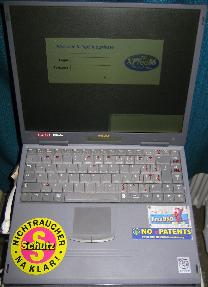
When it wouldn't turn off he pushed harder. Wrong ! The power
switch broke. Many laptops likely have equally small delicate
switches, be gentle, they're not rugged tower chassis switches.
Though the hands that broke this switch were big male, strong
hands, even smaller female hands might, (though perhaps
temperamentaly less likely to go the `more force' route  It's also possible that such
small fiddly plastic as you will see below may have been
overstressed previously by a sequence of people, so the last
person with whom it breaks, may not have been pushing that
hard. One can't know, so one can only remember: be gentle
 The outer plastic can (& in
this case does) disguise the switch as seeming bigger (&
assumedly stronger) than it really is.
- If they don't work on a gentle push, something's wrong,
pushing harder may not help, may break things, just hand it
back to owner, (without pushing harder, let the owner
break it!).
- To power off this laptop type, One must simultaneously
also push the Orange "Fn" key (bottom left).

So I took it apart (Notice main
board under keyboard is removed, exposing work mat on table.
Screen also unscrewed.)
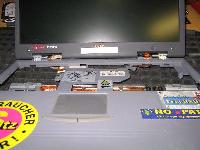
& found the broken off green power switch, (which was just
a piece of Green hard plastic, 2 pieces now, the big bit moved
to the left, used to be connected to the small bit still
connected to the edge of the chassis.

After removing the screen from the base unit, I had a clearer view of the green switch cover,
plus the actual tiny switch & even tinier black plastic
push switch in its shiny metal housing. That gives one a
clearer idea of just how fragile the whole thing is. More
pressure is Not what this power switch ever wanted.
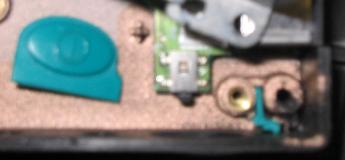
The coffee pot earlier propped up the dis-assembly while I inspected what I'd need to do.
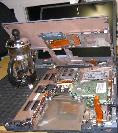 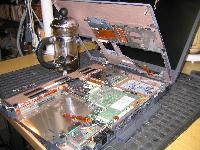
Another view of where the switch broke off from, note the
screen is no longer attached at top of picture.
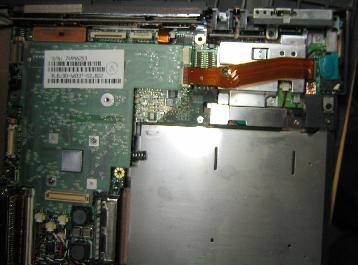
I used a hot glue gun to rejoin the 2
green bits of plastic, (not cyano -acrylate as that would just
have broken again on next flexing push). I also glued both to the chassis.Note I only glued it to the chassis at the corner
end where it was originally designed to bend. There's no glue
to the chassis the other end. It's thus now (& even before,
was) most appropriate to push the button on the end of the
button that's more towards the middle of the chassis, away from
the corner.
As my new construct would be stiffer than before, & the
green plastic would be under considerable stress before it bent
in enough across the gap, to push the small black switch,
before I installed the big Green bit
back in place, I previously cut, bent
& glued a thin strip of plastic (from a nylon washer) on
the left (toward middle of chassis) end of the green switch, to
fill up the gap. I then had to bend laptop
chassis outward while inserting the green switch cover.
The switch now has just about no free play, & bears
straight on to the black switch, the lightest of pushes
activates it.
Any excess pressure is now even more likely to break the
Real switch within (the tiny silver metal thing soldered to
the green board), & thus do more serious damage. (But it
wasn't worth tying to buy a new switch cover, as it's an old
laptop, & manufacturer DEC, was bought by Compaq, &
them by HP, & so it's obsolete, & also not my `Main'
laptop).
As before, the "F1" key Must be pressed simultaneously,
else the PC won't turn off (but will turn on).
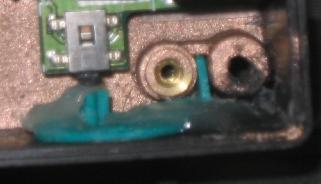
Because I didn't know what I was getting into, & was going slow, as I didn't want to break anything, this job
took over 3 hours, & I was using lots
of small tools, was well lit, lots of space etc. I had to
disconnect lots of tiny connectors, all very easily broken.
It's no job for anyone who might fumble, I
wouldn't recommend it 
The laptop is now repaired & again runs Free Software.
The stickers on the laptop:
Some other Hardware Projects I've Done
|
